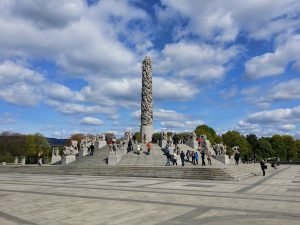
Exploring the Mighty Norsemen Gods & Myths
Do you ever wonder about the ancient gods worshipped by the fierce Norsemen? What if I told you that their myths and legends are brimming with stories of power, intrigue, and epic battles? Journey with us as we delve into the captivating realm of Norse mythology and unlock the secrets of the gods who shaped Viking culture.
Table of Contents
ToggleKey Takeaways:
- Discover the powerful gods and mythical beings worshipped by the ancient Norsemen
- Learn about the major gods and goddesses of the Norse pantheon
- Unearth the fascinating heroes and creatures of Norse folklore
- Explore the rituals and beliefs surrounding the worship of Norse gods during the Viking Age
- Gain insight into the rich tapestry of Viking culture and religious practices
The Norse Pantheon: Gods and Goddesses of Old
Welcome to the realm of Norse mythology, where the ancient Norse gods and goddesses held sway over the world. In this section, we will delve into the depths of the Norse pantheon to uncover the captivating stories and divine roles of these mighty deities.
At the center of the pantheon sits Odin, the Allfather and ruler of Asgard. Known as the god of wisdom, war, and poetry, Odin is often depicted with his iconic spear, Gungnir, and his familiars, the ravens Huginn and Muninn. As the chief god, Odin embodies the intellectual and spiritual aspects of the Norse mythology.
Another prominent figure in the Norse pantheon is Thor, the god of thunder and protector of mankind. With his mighty hammer, Mjölnir, Thor wields the power to summon thunderstorms and defend the realms from giants and other fearsome creatures. He represents strength, bravery, and the primal forces of nature.
Freya, the goddess of love, beauty, and fertility, also graces the pantheon with her presence. Known for her enchanting beauty and magical prowess, Freya is associated with desire, sensuality, and the cycle of life. She embodies both the nurturing and passionate aspects of the feminine divine.
The pantheon would not be complete without the mischievous trickster god Loki. Known for his cunning and shape-shifting abilities, Loki often finds himself tangled in the webs of deceit and chaos. Despite his unpredictable nature, Loki plays a crucial role in many key events in Norse mythology.
Now that we have acquainted ourselves with these prominent deities, let us embark on a journey through their fascinating stories and delve deeper into the rich tapestry of Norse mythology.
Heroes and Creatures of Norse Folklore
As we delve deeper into Norse mythology, we encounter an array of captivating heroes and mythical creatures that populate the rich tapestry of Norse folklore. These legendary figures and beasts are an integral part of the ancient Scandinavian tales, showcasing the immense creativity and imagination of the Norse people.
The Mighty Heroes
One of the most renowned heroes of Norse folklore is Beowulf, a brave warrior who defeated the monstrous Grendel and his mother, embodying the valor and strength admired by the Vikings. His epic exploits and unwavering courage have made him an emblematic figure in Norse mythology and a timeless symbol of heroism.
Another legendary hero is Sigurd, often referred to as Sigurd the Dragon Slayer. Armed with the powerful sword Gram, Sigurd embarked on daring adventures, battling fearsome dragons and overcoming treacherous obstacles. His tales of bravery and triumph continue to inspire awe and admiration.
The Enigmatic Creatures
Beyond the heroes, Norse folklore is also populated by a myriad of mythical creatures. Trolls, known for their immense strength and formidable size, feature prominently in Norse tales. These fearsome beings are often depicted as guardians of natural spaces and possess an otherworldly presence that both fascinates and intimidates.
Dwarves, on the other hand, are renowned for their exceptional craftsmanship. Masters of metalwork and stonemasonry, these diminutive creatures are responsible for forging some of the most powerful artifacts in Norse mythology, such as Thor’s hammer, Mjölnir. Their intricate work and magical creations are revered by gods and mortals alike.
Unveiling the Norse Mythological World
By exploring the heroes and creatures of Norse folklore, we gain a deeper understanding of the cultural significance and imaginative prowess of ancient Norse society. These captivating figures and beings transport us to a mythical realm where bravery, magic, and adventure intertwine, leaving an indelible mark on the fabric of Scandinavian folklore.
Rituals and Beliefs of the Viking Age
The Viking Age was a time of rich cultural practices and spiritual beliefs in ancient Norse society. The rituals and ceremonies surrounding the worship of viking gods and norse deities played a central role in the daily lives of the Norsemen, reflecting their deep connection to the supernatural realm.
Blót: One of the most important rituals during the Viking Age was the blót, a ceremony that involved offerings and sacrifices to viking gods. These rituals took place at specific times throughout the year, such as the winter solstice and the harvest season, and were held at sacred sites such as groves or hilltops. The blót aimed to establish a bond between humans and the gods and ensure the favor and protection of the deities.
- The Sumbel: Another notable ritual was the sumbel, a communal drinking ceremony that allowed individuals to connect with the gods and share stories and boasts among their kin. Participants would pass around a drinking horn, making toasts and dedications to the viking gods and other honored ancestors.
- Idol Worship: The Norsemen also revered physical representations of their gods in the form of idols. These idols, often carved from wood or stone, were placed in sacred spaces such as temples or household altars. The worship of these idols involved offerings and prayers, symbolizing the relationship between the mortal and divine realms.
“The offering of sacrifices is particularly important, calling the gods’ attention to the needs of the worshipper. Both personal and communal sacrifices were made. Personal sacrifices covered a wide range of activities: sacrifice for protection (the godsly inheritance taken to a relative clan); offerings and sacrifices to the gods for a successful outcome of planned journeys; offerings made after returning from a journey; prize bug after conquering someone in a battle, and revenge killing of a relative slain.” – Exploring the Viking World
The belief in viking gods and norse deities extended beyond rituals and ceremonies, permeating every aspect of the Norsemen’s lives. It influenced their legal systems, social structures, and even their concept of the afterlife. The gods and goddesses were seen as protectors and guides, and their names were invoked for good fortune or in times of difficulty.
The Viking Pantheon: Norse Gods and Goddesses
In Norse mythology, the gods and goddesses of the Viking pantheon held different domains and played distinct roles in the Norse cosmology. Here are some of the viking gods and norse deities that were highly revered during the Viking Age:
| Name | Domain | Symbol |
|---|---|---|
| Odin | Wisdom, war, and death | Ravens, wolves, and a spear |
| Thor | Strength and thunder | Mjolnir (hammer) |
| Freya | Love and fertility | Cats and a falcon feather |
| Loki | Trickery and chaos | An ever-changing appearance |
These gods and goddesses, along with many others, were worshipped and revered for their powers and influence over different aspects of life. Understanding their roles helps shed light on the rituals and beliefs of the Viking Age, and the deep connection the Norsemen had with their pantheon of viking gods and norse deities.
Conclusion
In conclusion, our exploration of Norse mythology and the powerful gods and mythical beings worshipped by the Norsemen has provided us with a deeper understanding of Viking culture and their unique religious practices. The Norse pantheon, consisting of gods and goddesses such as Odin, Thor, Freya, and Loki, played significant roles in the lives of the ancient Norse people.
Through their stories and beliefs, we have discovered a vibrant tapestry of Norse mythology. These ancient Norse gods and goddesses were not mere figures of worship but embodied various aspects of life, nature, and human emotions. Their tales continue to captivate and inspire to this day, showcasing the enduring power and influence of Norse mythology.
Moreover, we have also delved into the heroes and creatures of Norse folklore, from legendary figures like Beowulf and Sigurd to enigmatic beings like trolls and dwarves. They added depth and intrigue to the rich mythological world of the Norsemen, further highlighting the significance of these ancient tales in Viking society.
By uncovering the rituals and beliefs surrounding the worship of the Viking gods, we gain insight into how the ancient Norsemen honored their deities and integrated their religious practices into their daily lives. These rituals formed a vital part of their cultural identity, forming a strong bond between the Norsemen and their gods.
FAQ
What is Norse mythology?
Norse mythology encompasses the myths, legends, and beliefs of the ancient Norsemen. It is a rich tapestry of stories about gods, goddesses, heroes, and mythical creatures that were worshipped and revered by the Vikings.
Who are the major gods and goddesses in Norse mythology?
The Norse pantheon consists of numerous gods and goddesses. Some of the major deities include Odin, the king of the gods, Thor, the god of thunder, Freya, the goddess of love and beauty, and Loki, the trickster god.
What are the roles and significance of these gods and goddesses?
Each deity in Norse mythology has its unique role and significance. Odin, for example, is associated with war, wisdom, and magic, while Thor protects the realms of gods and humans. Freya is the goddess of fertility and love, while Loki brings mischief and chaos to the Norse mythological world.
Who are some famous heroes and creatures in Norse folklore?
Norse folklore is filled with legendary heroes and mythical creatures. Beowulf and Sigurd are renowned heroes known for their valor and heroic feats. Trolls, giants, and dwarves are some of the fascinating creatures that inhabit the Norse mythological realm.
How did the ancient Norsemen worship their gods?
The Norsemen had various rituals and ceremonies to honor their gods. They would offer sacrifices, engage in feasts and celebrations, and conduct ceremonies to seek blessings and protection. Norse mythology was deeply ingrained in their daily lives and cultural practices.
If you want to learn Norwegian, you can register for classes here. We look forward to hearing from you and helping you become fluent in Norwegian.




